According to statistics, 85% of people find that “spending money on travel is an investment worth making,” so the primary goal of travel agencies is to help customers make up their mind. In this entry, we’ll talk about the advantages of email marketing for your travel business and bring real-world examples of how to use it effectively.
Content:
- Why is email marketing suitable for the travel industry?
- Collect email addresses
- Use subscription forms
- Offer lead magnets
- Combine social media and email
- Segment your audience
- Start with a sign-up form
- Invite users to a preference center
- Hold a survey
- Build a behavior-based email marketing strategy
- Welcome new subscribers
- Celebrate special dates
- Keep an eye on abandoned searches
- Summing it up
Why is email marketing suitable for the travel industry?
Many travel agencies use email marketing as the main communication channel with their customers, and here are five reasons why:
- It helps you catch warm quality leads and turn them into customers and brand advocates.
- It allows your travel agency to provide customers with details and updates on the date and time of their trip automatically.
- It enables you to create relevant offers based on the previous activity of your subscribers.
- It brings high ROI for the accessible price you pay — up to $38 for every $1 spent.
- It generates good open and click-to-open (CTO) rates, while the number of unsubscribes and spam complaints remains low.

According to Litmus, people start planning vacations mostly from one to three months in advance. This time is enough for you to assist your customers in many ways, with email content too. So, let’s see how you can get high conversions and deliver expectations of your traveling subscribers.
Collect email addresses
Email marketing starts with a mailing list, and travel email marketing is not an exception. To keep your sender reputation high and prevent spam traps from getting into your list, you need to build a list of engaged and active subscribers on your own. If you already have a mailing list make sure to keep it healthy.
Use subscription forms
Introduce a subscription form at the very point that you meet potential customers — on your website, blog, or landing page. So that it is easier to choose from the pop-up, floating, fixed or embedded forms, let’s explore some examples.
You can add an embedded form at any place of your website you find potentially suitable for conversion. Take a look at the example from Worldwide Horizons. Their subscription form is located in the footer, and it’s highly visible thanks to the bright yellow which matches the color scheme of the brand logo, website call-to-action buttons and details resting on the menu bar.

A pop-up, in turn, will appear on the website after a specified time or based on the mouse movement as a visitor navigates across the page. Travel and Leisure use this type of form reinforced with the engaging CTA copy, which contains verbs that encourage actions, pronouns “my” and “I” that speak to website visitors and make them feel more personally connected.

A floating form stays in the specified part of the page and remains there while a visitor scrolls the page. Take a look at this example from Grand American Adventures. The form itself is short, designed in the corporate colors with the clear CTA copy.

By the way, brevity is not obligatory. You can be more specific in your subscription form and describe the benefits of joining your mailing list right in it — just like Vueling Club did in their embedded form:

Offer lead magnets
One of the surest ways to attract new customers is to use a lead magnet — a deal, a discount, a piece of useful content offered in exchange for subscription. For instance, Book It offer $100 in instant savings to new subscribers.

We decided to check if the company sticks to its promises, so we signed up for their emails. And indeed, a few seconds later we received two discount codes directly to our mailbox:
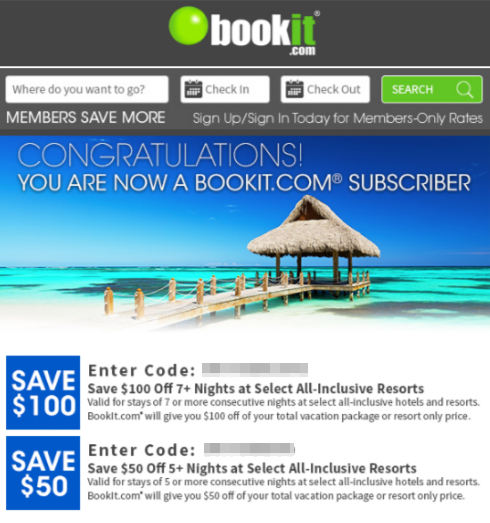
Combine social media and email
Email and social media are effective channels for getting new customers, whereas their combination will even multiply possible results. Your first step should be placing a sign-up button on your Facebook page. Check out this example from Travel and Leisure:

As soon as a person clicks “Sign Up,” a registration form opens up in a new tab. Notice the number of choices a user can make to personalize their inbox:

Afterwards, you can include links to your official social media pages to your travel email marketing campaigns so that your recipients will have a possibility to choose a preferable communication channel. See how Hipmunk incorporated social media buttons in their email footer:

Segment your audience
Travel and tourism companies can boast about having much more personal data than any other industry. This is a real advantage they can use to segment their mailing lists and be more personalized. We offer three ways to segment your audience, but keep in mind that there are a lot more options.
Start with a sign-up form
Ask visitors to choose their email preferences during the sign-up stage. Secret Escapes, for example, provide two different ways, both explained.

Tablet also ask their “one-step-away” subscribers to choose whether they want to receive the deal-packed emails or just the top news.

Invite users to a preference center
Invite users to pick up the content of your emails in their preference centers. Take a look at the example from Kayak — the company places a link to the preference center in the email footer:

The preference center itself looks like this:

Pay attention to the “unsubscribe” option at the end of the page: it should be always visible in case a subscriber is no longer interested in your content.
Jetsetters, in its turn, offer to choose not only the topics themselves but also the frequency of emails for even better customer experience.

Hold a survey
Another option to get to know your subscribers better is by holding a survey. For example, you can ask what types of content they are more interested in. Booking Buddy, for instance, hold surveys on general topics not related to subscribers’ trips and visits to get as much extra information as possible.
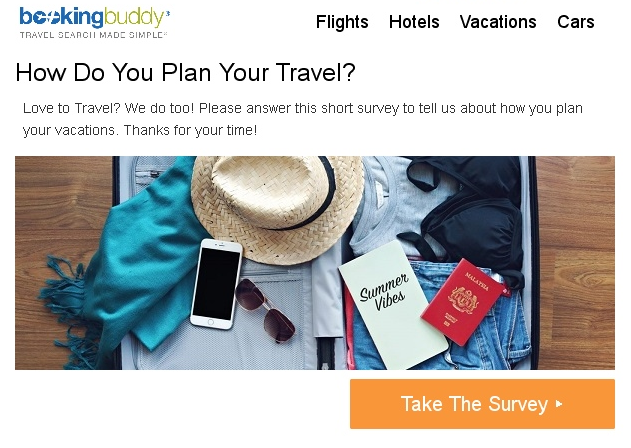
Build a behavior-based email marketing strategy
Behavioral emails are automated targeted messages that you send customers based on their interactions with your company through multiple channels — triggers. For travel and tourism agencies such triggers can be the following:
- subscription or registration;
- abandoned browse;
- booking confirmation or cancellation;
- special dates.
Welcome new subscribers
Set up a welcome email that will be launched once a new email address appears on your list. Use this email to
- introduce your company and promote your hot or best-selling tours;
- set expectations for newcomers and invite them to join your social media channels;
- give instructions about how to use your website or order a tour.
Click&Go, for example, provide new subscribers with a clear guidelines on how the service works.
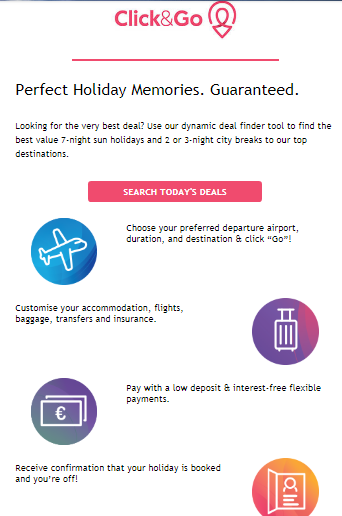
Tablet, for their part, set the expectations of their subscribers right from the beginning.

One more example of a welcome email is from Travel and Leisure. It includes a breath-taking image and a reminder of what a user has subscribed for.
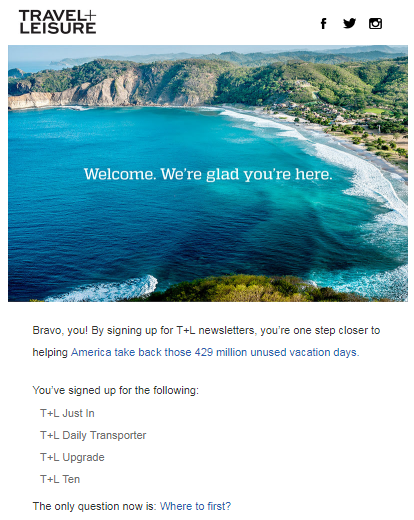
Celebrate special dates
Incorporate milestone emails in your travel email marketing strategy. These are messages used to reward loyal customers with special birthday offers, improve customer retention with can’t-miss anniversary deals, or keep subscribers engaged with extra discounts on the occasion of national holidays.
Below is a colorful email from Britannia Hotels with instructions on how a person can get their bubbly treat on their birthday:
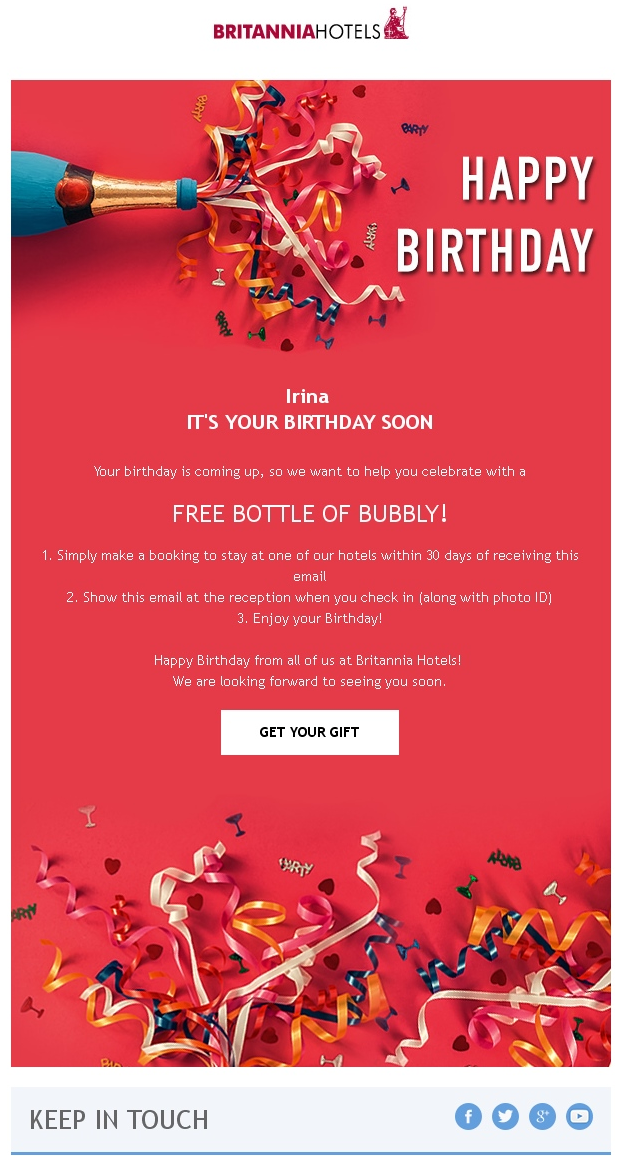
Another example is a membership anniversary email from Hipmunk with a 10% off inside:
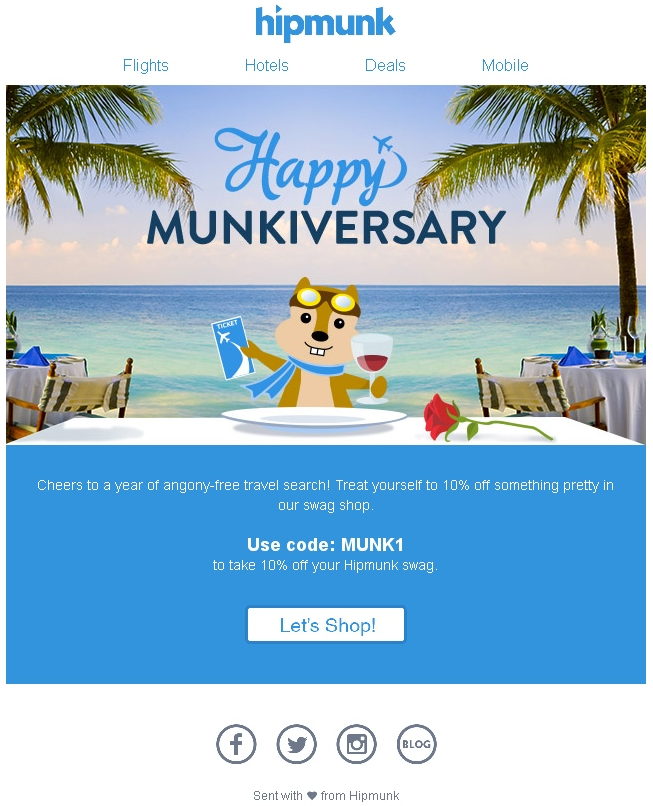
Keep an eye on abandoned searches
Send out automated emails to subscribers who were browsing your website but didn’t order anything. Pick them up right where they left off. To provide an example, we browsed hotels in Spanish resort cities on Booking.com. The day after, an email appeared in our inbox offering hot choices of the deals in the cities we had surfed.
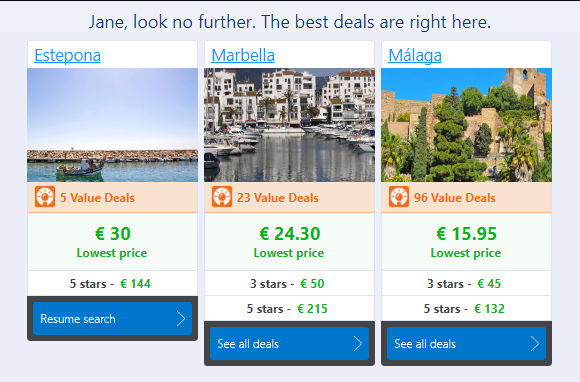
Summing it up
To attract new leads to your travel-related business and nurture them into loyal customers and brand advocates, develop a holistic email marketing strategy:
- Build a mailing list of real users through subscription forms and social media, and don’t forget to offer lead magnets.
- Segment your audience using information you got from their preferences, their choices at the sign-up stage, or results of surveys and tests.
- Set up triggered emails — welcome, abandoned browse, milestone and others. Use Automation 360 to simplify your email marketing routine.





